Introduction
Nestled in the heart of Europe, Prague seamlessly blends a rich history, captivating culture, and undeniable charm, making it a must-visit destination for travellers. Known as the “City of a Hundred Spires,” Prague’s skyline is adorned with Gothic churches, baroque buildings, and medieval bridges that tell stories of its illustrious past. From its vibrant old town, where cobblestone streets weave through busy squares, to its serene riverbanks offering breathtaking views, Prague offers a unique journey through time and architecture. In this guide, I’ll explore the best things to do in Prague, delving into its history, culture, and dining experiences.
I’ll take you through my personal journey in Prague, sharing the historical significance of this magnificent city and my own experiences exploring its wonders. I’ll take you from the grandeur of Prague Castle and the haunting history of the Old Jewish Cemetery to the iconic Charles Bridge and the enchanting streets of Malá Strana. In addition, I’ll provide insights and tips for making the most of your visit. Along the way, I’ll share some lesser-known stories, such as the infamous Defenestration of Prague and my favourite spots to unwind with a traditional Czech beer.
Join me as I uncover the layers of Prague’s past and present. Discover why this city, with its timeless appeal, continues to captivate the hearts of travellers from around the world. Whether planning your first trip or revisiting this timeless city, this guide will help you explore Prague’s treasures and create unforgettable memories.
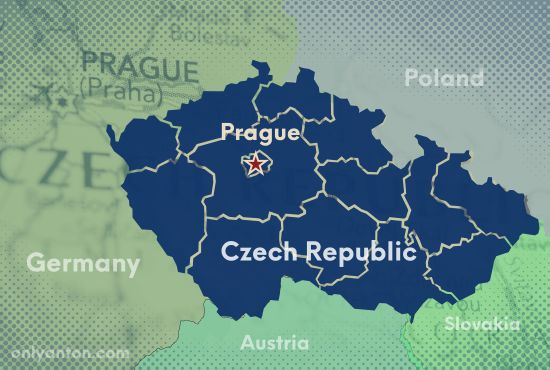
Location and Historical Context
Geographic Orientation
Prague, the capital city of the Czech Republic, is centrally located in Europe. It lies along the banks of the Vltava River, which meanders through the city, adding to its picturesque charm. Historically, the city’s central location has made it a significant crossroads for trade, culture, and politics in Europe. The Vltava River is the longest in the Czech Republic, flowing from the country’s southwestern region to the north, where it merges with the Elbe River. This strategic positioning has allowed Prague to flourish as a key urban centre since its founding over a millennium ago.
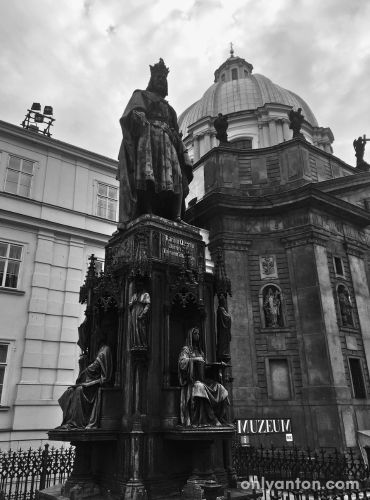
Historical Background
Prague’s historical significance is deeply rooted in its long and storied past, dating back to its founding in the 9th century. During the medieval period, Prague began to rise to prominence, particularly under the reign of Charles IV. As the capital of the Kingdom of Bohemia, Prague became a major cultural and political hub in Central Europe. The city’s golden age came in the 14th century under Charles IV, who was both King of Bohemia and Holy Roman Emperor.
The Holy Roman Empire and Charles IV
Charles IV, crowned Holy Roman Emperor in 1355, was pivotal in shaping Prague’s destiny. Under his rule, Prague transformed into Europe’s intellectual and cultural centre. Charles IV founded Charles University in 1348, the first university in Central Europe, which attracted scholars from across the continent. He also commissioned the construction of many significant structures, including the Charles Bridge, Saint Vitus Cathedral, and the New Town (Nové Město), expanding the city’s influence and beauty.
During his reign, Charles IV’s vision and patronage led to a flourishing of Prague’s arts, architecture, and education, marking an era often called the Golden Age of Prague. This period saw the city become a beacon of learning, culture, and architectural innovation. The result is a legacy that continues to attract visitors and scholars to this day.
Transition from Czechoslovakia to the Czech Republic and Czechia
In more recent history, Prague has been at the heart of significant political changes in Central Europe. After World War I, the independent state of Czechoslovakia was formed, with Prague as its capital. The city witnessed tumultuous times during World War II and the subsequent communist era. However, the Velvet Revolution in 1989 marked the peaceful end of communist rule in Czechoslovakia, establishing a democratic government.
In 1993, Czechoslovakia peacefully split into two separate countries: the Czech Republic and Slovakia. Prague remained the capital of the Czech Republic. In 2016, the Czech government officially approved using the short-form name Czechia to refer to the country, although the official long-form name remains the Czech Republic.
Summary
Prague’s location and rich historical context make it a unique and fascinating destination. Prague’s history is woven into the fabric of European culture and politics, from its central European position along the Vltava River to its pivotal role in the Holy Roman Empire under Charles IV. Understanding this context enhances the experience of exploring its ancient streets, majestic castles, and vibrant cultural scenes.
Exploring the Different Quarters of Prague
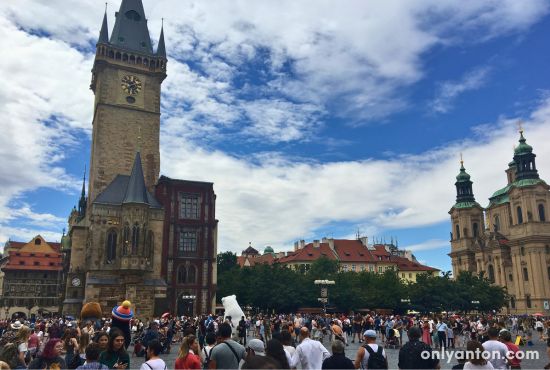
Old Town (Staré Město)
Prague’s Old Town, known as Staré Město, is a historic and cultural heart that offers a captivating journey through centuries of European history. This quarter is home to some of Prague’s most iconic sites and monuments, each brimming with stories of the city’s past.
Old Town Square
Old Town Square is the central hub of Staré Město and one of the most picturesque squares in Europe. Surrounded by stunning Gothic, Baroque, and Romanesque architecture, the square has been a significant public space since the 12th century. It has witnessed numerous historical events, from medieval markets to political demonstrations. Key attractions around the square include the Gothic Church of Our Lady before Týn, its impressive twin spires dominating the skyline, and the Baroque St. Nicholas Church, renowned for its beautiful frescoes and ornate interior.
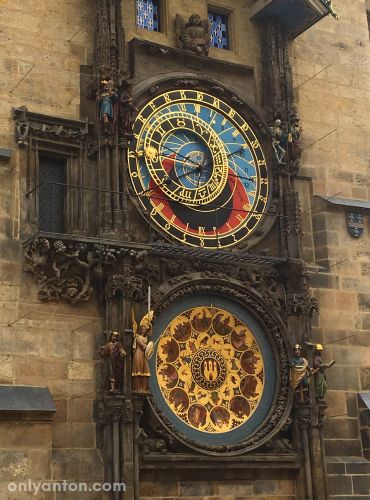
Astronomical Clock
Located on the southern wall of the Old Town Hall, the Astronomical Clock, or Orloj, is one of Prague’s most famous landmarks. Installed in 1410, it is the third-oldest astronomical clock in the world and the oldest one still in operation. The clock tells the time and displays astronomical information, such as the positions of the sun and moon and various Christian holidays. Every hour, the clock comes to life with a show featuring the Twelve Apostles, which draws crowds of tourists. The intricate mechanics and historical significance of the clock make it a must-see.
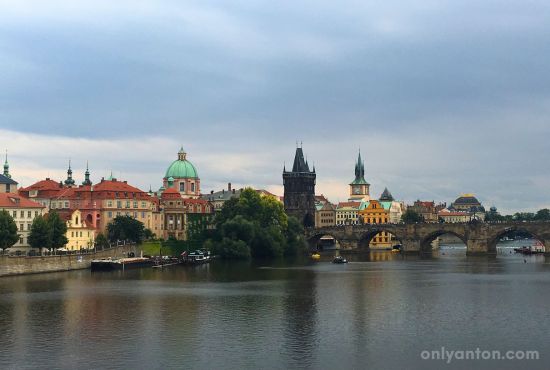
Charles Bridge
Connecting Old Town with Malá Strana, the Charles Bridge is a historic stone arch bridge that spans the Vltava River. Commissioned by King Charles IV in 1357, the bridge is adorned with 30 statues of saints, each with its own unique story. The bridge is an architectural marvel with Gothic towers on both ends—the Old Town Bridge Tower and the Lesser Town Bridge Tower. It’s best to visit the Charles Bridge early in the morning or late in the evening to avoid the crowds and enjoy the serene views of the city and river.
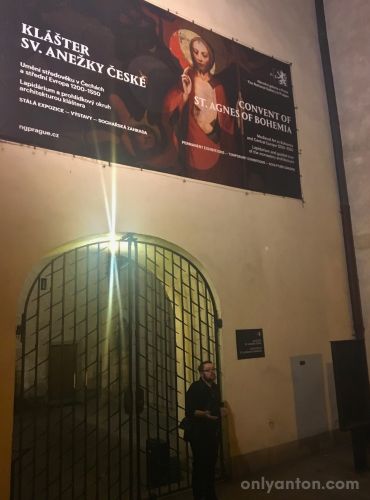
Convent of St. Agnes
The Convent of St. Agnes of Bohemia, founded in 1231, is one of Prague’s most significant medieval buildings. This former convent now houses the National Gallery’s collection of medieval and early Renaissance art. Its Gothic architecture and serene atmosphere provide a glimpse into Prague’s religious and cultural heritage. The convent played a crucial role in the city’s spiritual and artistic life, making it a worthwhile visit for those interested in history and art.
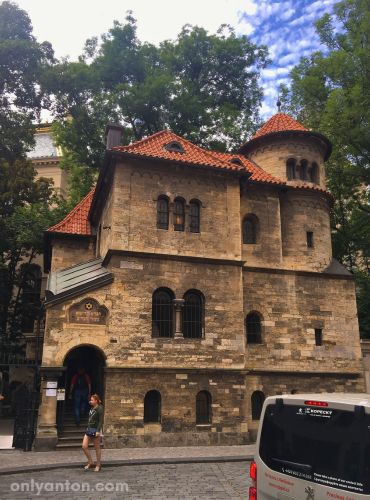
Old Jewish Cemetery
The Old Jewish Cemetery in Prague is one of Europe’s largest and oldest Jewish cemeteries, dating back to the early 15th century. This cemetery is a poignant reminder of the Jewish community’s long history in Prague. Despite the limited space, it is estimated that over 12,000 tombstones are present, with many more bodies buried in layers beneath the ground. Notable figures buried here include Rabbi Judah Loew ben Bezalel, also known as the Maharal of Prague, a significant Talmudic scholar and Jewish mystic.
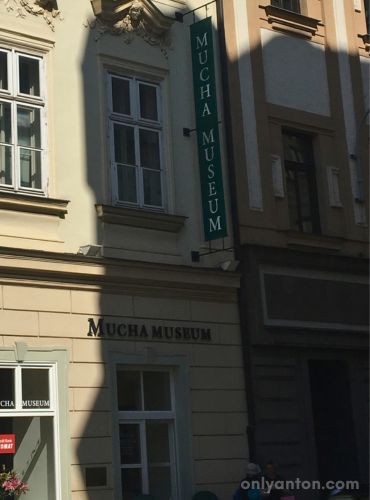
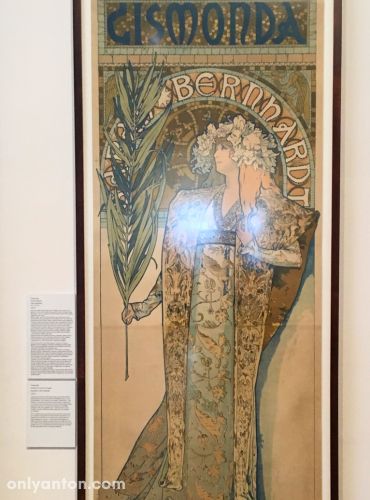
Mucha Museum
For those interested in Art Nouveau, the Mucha Museum, dedicated to the work of Alphonse Mucha, is a must-visit. Located near Wenceslas Square, this museum houses an extensive collection of Mucha’s posters, paintings, and personal artifacts. Mucha’s distinctive style and significant contributions to the Art Nouveau movement are well represented, providing a fascinating insight into his life and work.
Summary
Old Town Prague offers a rich tapestry of history, culture, and architecture that reflects the city’s vibrant past. From the bustling Old Town Square and the intricate Astronomical Clock to the serene Convent of St. Agnes and the historic Old Jewish Cemetery, each site tells a unique story. As you stroll through the cobblestone streets, you’ll feel the echoes of centuries gone by, making Staré Město a captivating destination for any traveller.
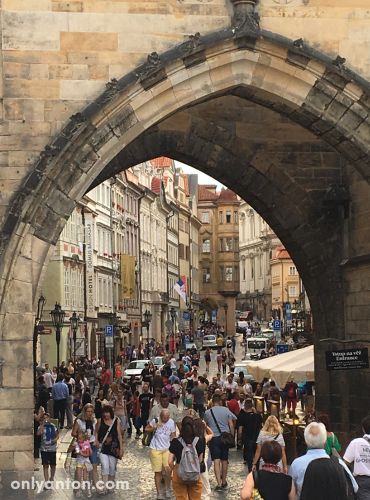
Malá Strana (Lesser Town)
Malá Strana, or Lesser Town, is one of Prague’s most picturesque quarters. The area is nestled between the Vltava River and the hills leading up to Prague Castle. This area is characterized by its charming narrow streets, Baroque buildings, and lush gardens, offering a delightful blend of history and beauty.
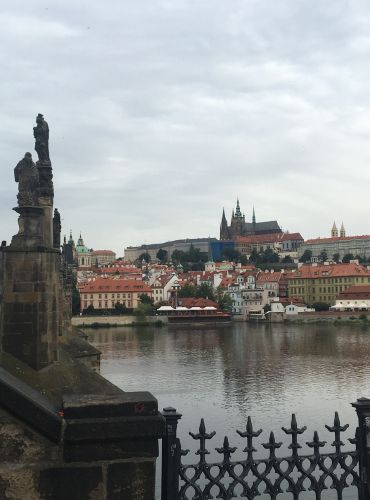
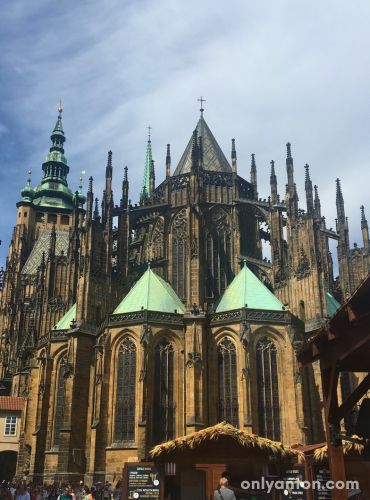
Prague Castle and St. Vitus Cathedral
Prague Castle, perched atop a hill overlooking the city, is a historic symbol of the Czech state and the largest ancient castle complex in the world. Founded in the 9th century, it has been the seat of Czech kings, emperors, and presidents. It encompasses a variety of architectural styles, from Romanesque structures dating back to the 10th century to Gothic modifications in the 14th century.
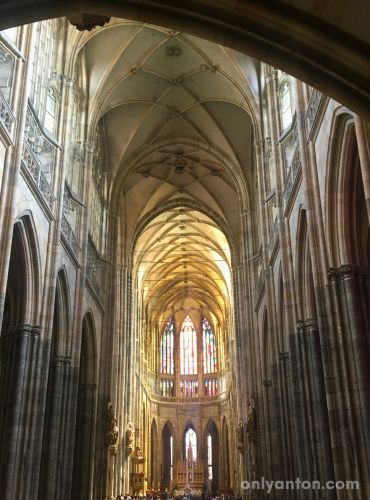
At the heart of Prague Castle stands St. Vitus Cathedral, an architectural masterpiece and the most important church in the country. Construction began in 1344 under Emperor Charles IV and took nearly 600 years to complete. The cathedral is a prime example of Gothic architecture, with its towering spires, intricate stained glass windows, and a stunning rose window. It houses the tombs of many Bohemian kings and Holy Roman Emperors, including Charles IV himself. Visitors can also see the Crown Jewels displayed on special occasions.
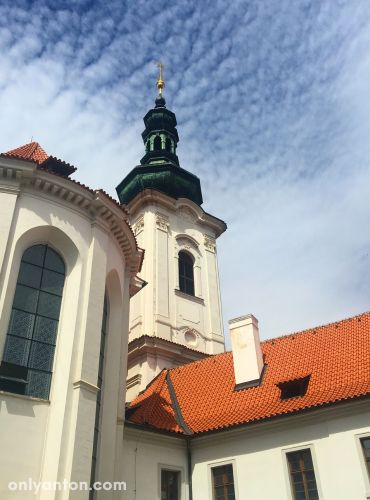
Strahov Monastery
Founded in 1143, Strahov Monastery is a significant historical and religious site in Malá Strana. This Premonstratensian abbey is known for its magnificent library, which is one of the most beautiful in the world. The library contains over 200,000 volumes, including medieval manuscripts, maps, and globes. The Theological Hall, with its ornate ceiling frescoes, and the Philosophical Hall, lined with wooden bookcases and adorned with Baroque artwork, are particular highlights. The monastery also houses a valuable collection of religious artifacts and historical objects, offering a fascinating glimpse into the region’s spiritual and cultural heritage.
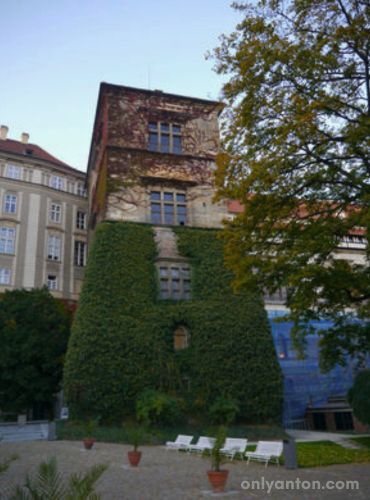
The Defenestration of Prague
One of the most infamous events in Prague’s history is the Defenestration of Prague, which took place in 1618 and marked the beginning of the Thirty Years’ War. This event occurred when Protestant nobles, angered by the Catholic Habsburg rulers’ policies, threw two Catholic officials out of a window of the Prague Castle. Remarkably, the officials survived the 70-foot fall, landing in a pile of manure or a slope, depending on the account.
The Defenestration of Prague had profound consequences, igniting a conflict that ravaged Europe for three decades. It highlighted the deep religious and political divisions of the time and set the stage for significant changes in the European political landscape. The event is a stark reminder of the volatile history that has shaped Prague and the broader region.
Summary
Malá Strana is a treasure trove of historical and cultural landmarks, each with a unique story. From the grandeur of Prague Castle and the awe-inspiring St. Vitus Cathedral to the intellectual riches of Strahov Monastery and the dramatic tale of the Defenestration of Prague, this quarter offers a rich tapestry of experiences. Exploring Malá Strana provides a deeper understanding of Prague’s complex history and enduring charm.
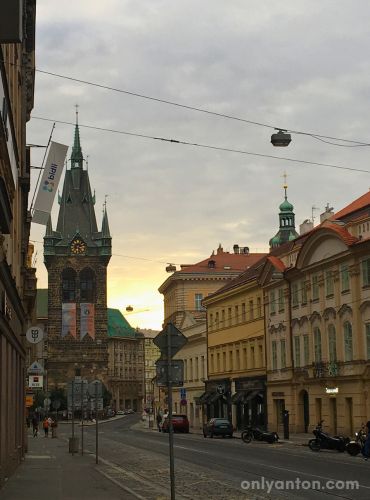
Nové Město (New Town)
Nové Město, or New Town, is an essential part of Prague that offers a vibrant blend of history, culture, and modernity. Established in the 14th century by Charles IV, this quarter was designed to expand Prague beyond its medieval confines and provide a space for commerce and residence. Today, it is a testament to Prague’s evolution, combining historic sites with contemporary attractions.
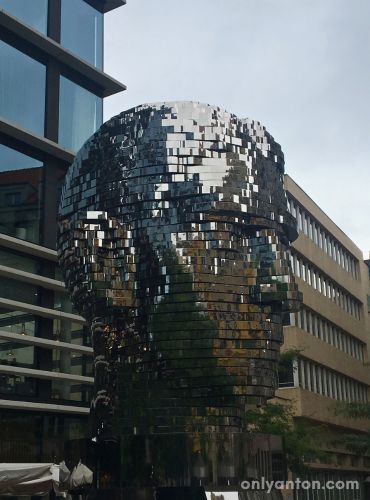
Kafka’s Statue
Franz Kafka, one of the most influential writers of the 20th century, is commemorated with a striking statue in Nové Město. Created by artist Jaroslav Róna, this surreal bronze sculpture depicts Kafka riding on the shoulders of a headless, suit-clad figure, symbolizing his existential themes and the dualities in his work. Another memorial to Kafka is located outside the Quadrio shopping mall. This outdoor kinetic sculpture, created by David Černý, is called “The Head of Franz Kafka.” These statues are artistic homages and cultural landmarks that reflect Kafka’s deep connection to Prague and his literary legacy.
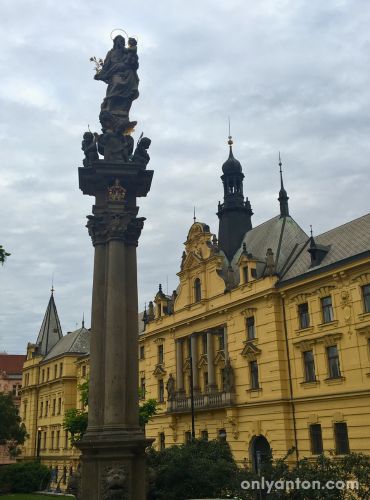
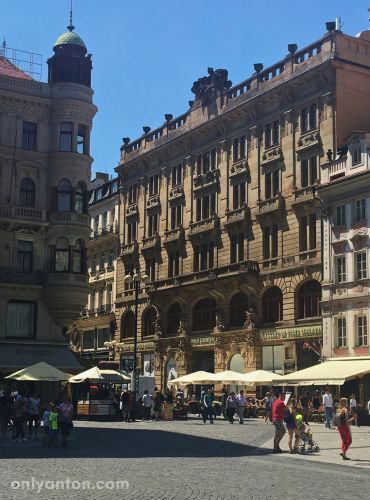
Wenceslas Square
Wenceslas Square is the beating heart of New Town and a central hub of activity in Prague. Originally a horse market, this expansive boulevard has become a focal point for commerce, culture, and political events. Dominated by the impressive statue of St. Wenceslas, the patron saint of Bohemia, the square is a testament to the city’s resilience and spirit. The equestrian statue, crafted by Josef Václav Myslbek, is surrounded by four other saints and serves as a popular meeting point.
Wenceslas Square has been the stage for numerous historical events, including the Declaration of Independence of Czechoslovakia in 1918 and the Velvet Revolution in 1989. Today, it buzzes with life, lined with shops, restaurants, and cafes, offering visitors a dynamic blend of old and new.
Národní Museum
Located at the top of Wenceslas Square, the Národní Museum (National Museum) is one of Prague’s most significant cultural institutions. This neo-Renaissance building, founded in 1818, houses extensive collections covering natural history, arts, music, and more. The museum’s grand architecture and impressive exhibitions provide deep insights into Czech and global history, making it a must-visit for history and culture enthusiasts.
Dancing House
The Dancing House, known locally as Tančící dům, is a standout example of modern architecture in Prague. Designed by Frank Gehry and Vlado Milunić, this deconstructivist building resembles a pair of dancers, earning it the nickname “Fred and Ginger.” Completed in 1996, the Dancing House symbolizes the city’s creative spirit and its embrace of innovative design. Visitors can explore its art gallery and enjoy panoramic views of Prague from the rooftop restaurant.
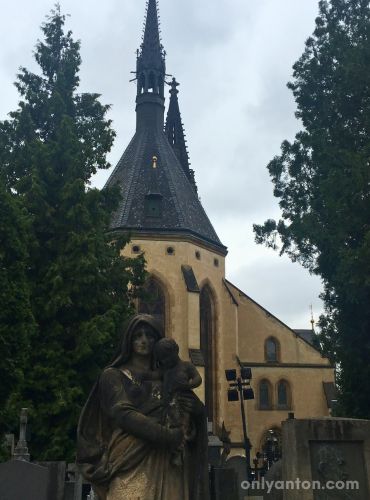
Vyšehrad
Although technically part of the Vyšehrad district, Vyšehrad is often associated with New Town due to its proximity and historical connections. Vyšehrad is an ancient fortress that predates the establishment of Prague Castle. It offers a tranquil escape from the bustling city, with its impressive fortifications, gardens, and stunning views of the Vltava River.
Vyšehrad’s notable sites include the Basilica of St. Peter and St. Paul, a neo-Gothic church with striking interior frescoes, and the Vyšehrad Cemetery, where many famous Czechs are buried, including composers Antonín Dvořák and Bedřich Smetana. The Legends of Vyšehrad add a mystical layer to its history, making it a place of both cultural and spiritual significance.
Summary
Exploring Prague’s different quarters offers a comprehensive view of the city’s rich tapestry of history, culture, and architectural beauty. Each area contributes uniquely to the city’s allure, from Old Town’s medieval charm to New Town’s vibrant life. As we move forward, let’s delve into the cultural experiences and artistic highlights that make Prague an enchanting destination.
Prague’s Food and Drink
Prague tantalizes the taste buds with its rich culinary traditions and renowned beer culture. The city’s food scene is a delightful blend of hearty meals, traditional pastries, and world-famous brews that reflect the country’s deep-rooted gastronomic heritage.
Overview of Czech Food
Czech cuisine is known for its comforting and hearty dishes, which often feature meats, root vegetables, and thick sauces. It reflects the region’s agricultural traditions and colder climate and provides warmth and sustenance.
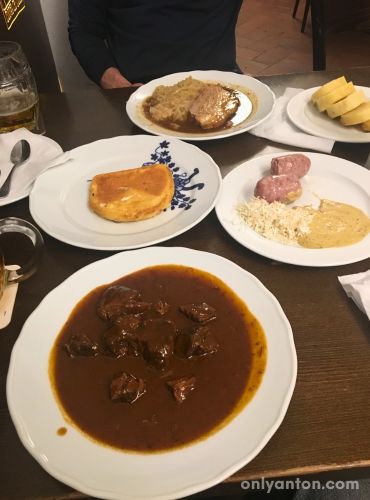
Iconic Dishes
Svíčková: This is a classic Czech dish featuring marinated beef sirloin in a creamy vegetable sauce. It is typically served with dumplings, cranberries, and a dollop of whipped cream. The beef is often marinated in a mix of root vegetables, vinegar, and spices before being slow-cooked to tender perfection. Svíčková is a staple at festive occasions and family gatherings.
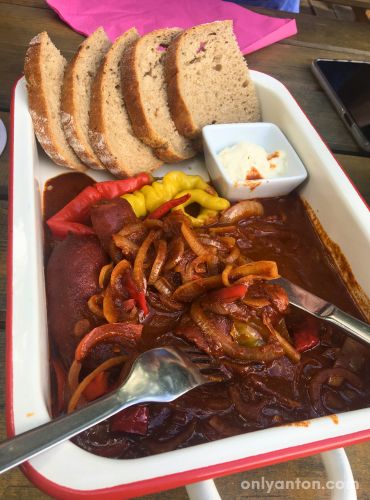
Goulash: While goulash is originally Hungarian, the Czech version is a beloved staple. Czech goulash is a rich, thick stew made with beef, onions, paprika, and other spices. It’s often served with dumplings or bread, making it a hearty and satisfying meal. Each region and even each cook might have their own variation of this classic dish.
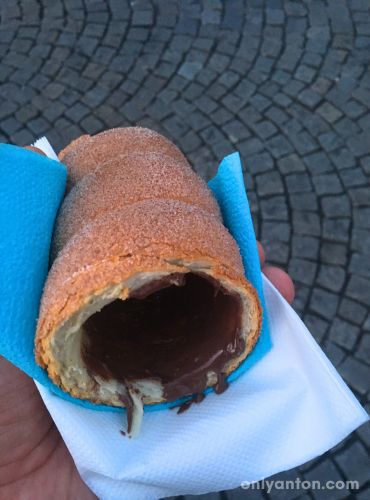
Trdelník: This sweet pastry is a popular treat in Prague, especially among tourists. Trdelník, also known as chimney cake, is made from rolled dough wrapped around a stick, grilled, and then coated with sugar and walnuts. It’s crispy on the outside and soft on the inside, sometimes filled with whipped cream, ice cream, or chocolate for an extra indulgence.
Beer Culture in Prague
The Czech Republic is renowned for its beer culture, and Prague is the heart of this tradition. The country boasts the world’s highest beer consumption per capita, and its beer-making history dates back over a thousand years.
Pilsner Beer: The most famous Czech beer is the pilsner, a pale lager originating in Plzeň in 1842. Pilsner beer is known for its light, golden colour and crisp, refreshing taste. The original pilsner, Pilsner Urquell, is still brewed in Plzeň and is considered the benchmark for all pilsners.
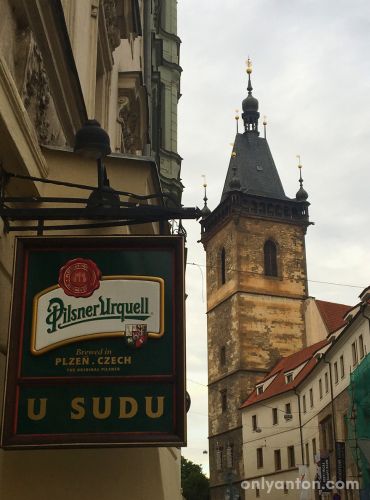
Pilsner Urquell: This iconic beer was the world’s first pale lager and set the standard for the pilsner style. Pilsner Urquell’s distinctive flavour comes from its unique brewing process, including triple decoction mashing and Saaz hops, known for their mild, earthy, and floral character. It’s a must-try for any beer enthusiast visiting Prague.
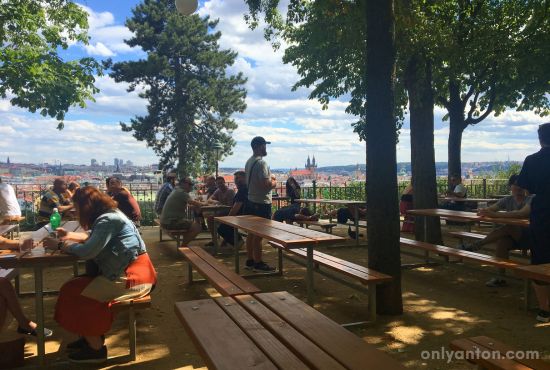
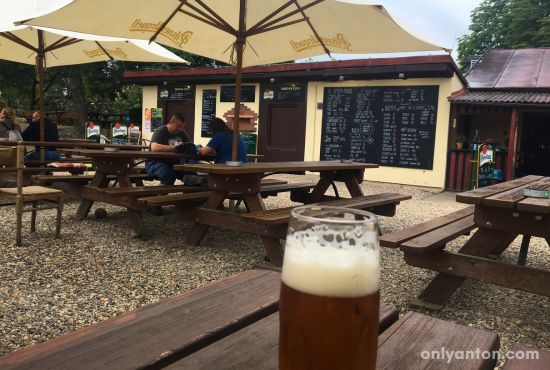
Prague’s beer gardens are a testament to the city’s love for beer. Places like Letenské sady and Vyšehrad offer great brews, stunning views, and a relaxed atmosphere, perfect for enjoying a cold pint on a warm day.
Stay tuned for future blog posts on the Only Anton travel blog, where I’ll delve deeper into Czech cuisine and beer culture. Whether you’re a food lover or a beer connoisseur, Prague offers a wealth of culinary delights waiting to be discovered.
Accommodations in Prague
Finding the right place to stay can significantly enhance your travel experience. Prague offers a wide range of accommodations to suit different budgets and preferences. Here are some recommendations across budget, mid-range, and luxury categories, along with my personal experiences at two excellent hotels.
Budget Accommodations
1. Onefam Home Hostel Prague: Located in the heart of Prague, Onefam Home Hostel Prague offers travellers a friendly and vibrant atmosphere. It provides clean and comfortable dormitory-style rooms, free Wi-Fi, and social activities that make it easy to meet other travellers. The hostel is within walking distance of major attractions like Old Town Square and the Astronomical Clock.
2. Sir Toby’s Hostel: This charming and cozy hostel is located in the Holešovice district. It features unique decor, a welcoming common area, and a garden. The hostel also offers private rooms for those seeking more privacy. It’s an excellent choice for travellers looking to experience local culture while staying within a budget.
3. Mosaic House Design Hotel: Mosaic House combines a hostel’s affordability with a hotel’s comfort. It offers a variety of room options, from shared dormitories to private rooms and suites. The eco-friendly hotel is located near the Dancing House and within easy reach of major attractions.
Mid-Range Accommodations
1. Hotel Merkur: Hotel Merkur is conveniently located near Florenc Metro Station, making it easy to explore the city. It offers comfortable rooms, a delicious breakfast buffet, and friendly service. The hotel’s central location and modern amenities provide excellent value for money.
2. Archibald At the Charles Bridge: Situated right next to the iconic Charles Bridge, this hotel offers charming and comfortable accommodations with a historic touch. Guests can enjoy beautiful views of the bridge and the Vltava River and easy access to both Old Town and Lesser Town.
3. Residence Agnes: Residence Agnes is a highly-rated boutique hotel in the Old Town. It offers spacious and elegantly decorated rooms, excellent service, and a complimentary breakfast. The hotel’s location makes it an ideal base for exploring Prague’s historic sites.
Luxury Accommodations
1. Art Nouveau Palace Hotel: The Art Nouveau Palace Hotel is a stunning luxury hotel near the Mucha Museum. The hotel’s decor and ambiance reflect the Art Nouveau style, providing a unique and immersive experience. It offers elegantly appointed rooms, top-notch service, and a central location that makes exploring Prague’s cultural and historical sites easy.
2. Hilton Prague Old Town: The Hilton Prague Old Town is a modern and luxurious hotel ideally situated for exploring the historic heart of Prague. The hotel provides excellent amenities, including a fitness centre, an indoor pool, and fine dining options. Its central location means you are just steps away from significant landmarks like the Old Town Square and Charles Bridge.
3. Four Seasons Hotel Prague: Located along the Vltava River, the Four Seasons Hotel Prague offers a blend of historic charm and modern luxury. The hotel features beautifully designed rooms, exceptional dining experiences, and stunning views of Prague Castle. It’s an ideal choice for travellers seeking a truly indulgent stay.
Choosing the right accommodation can make your stay in Prague even more enjoyable. Whether you’re travelling on a budget, seeking mid-range comfort, or indulging in luxury, Prague has something to offer for every type of traveller.
Practical Tips for Travellers
Travelling to Prague can be a delightful experience when you are well-prepared. Here are some practical tips to help you make the most of your visit:
Language
Language Basics: Prague’s official language is Czech. While many people in the city, especially those working in tourism, speak English, learning a few basic Czech phrases can be beneficial and will be appreciated by locals.
- Hello: Ahoj (informal), Dobrý den (formal)
- Thank you: Děkuji
- Please: Prosím
- Yes/No: Ano/Ne
Communication: You’ll find English-speaking guides and information in tourist areas. However, in more residential or less touristy parts of the city, knowledge of English may be less common.
Currency
Currency: The official currency is the Czech koruna (CZK). While some places accept euros, using the local currency is generally better to avoid unfavourable exchange rates.
Exchange and ATMs: Exchange offices and ATMs are widely available. To avoid excessive fees, use ATMs affiliated with major banks. Always check the exchange rate before exchanging money.
Credit Cards: Major credit cards are widely accepted in hotels, restaurants, and shops. However, having some cash on hand is always good, especially for small purchases or in local markets.
Weather Overview
Spring (March-May): The weather is mild and pleasant, ranging from 5°C to 15°C (41°F to 59°F). Spring is a great time to visit, with gardens blooming and smaller crowds.
Summer (June-August): It is warm and busy, with temperatures ranging from 15°C to 25°C (59°F to 77°F). Summer is the peak tourist season, so expect larger crowds at popular sites.
Autumn (September-November): This season is cool and colourful, with temperatures ranging from 5°C to 15°C (41°F to 59°F). Autumn offers beautiful fall foliage and a more relaxed atmosphere.
Winter (December-February): The weather is cold and festive, with temperatures often below freezing. Prague transforms into a winter wonderland, especially during the Christmas markets.
Best Times to Visit
Spring and Autumn: These shoulder seasons are ideal for visiting Prague due to the mild weather and fewer tourists. You’ll find it easier to explore popular attractions without the summer crowds.
Winter: December is a magical time to visit for the Christmas markets and holiday decorations. However, be prepared for cold weather and shorter daylight hours.
Local Etiquette
Politeness: Czechs value politeness and respect. They greet people with a handshake and use formal titles and last names until invited to use first names.
Quiet and Reserved: Czechs tend to be more reserved in public. Keep your voice down and avoid drawing unnecessary attention to yourself.
Tipping: Tipping is customary in restaurants. A 10% tip is considered standard, but a small additional amount is appreciated if the service charge is included.
Dress Code: When visiting religious sites, dress neatly and conservatively. Casual attire is acceptable in most other places but avoid overly revealing clothing.
Public Transport Etiquette
Trams and Buses: Public transportation is efficient and widely used. Always validate your ticket upon boarding, and give up your seat to older people or those in need.
Escalators: Stand on the right side of escalators to allow people to pass on the left.
By keeping these practical tips in mind, you’ll be well-prepared to enjoy all that Prague has to offer. Understanding the local language, currency, climate, and etiquette will enhance your travel experience and help you easily navigate the city.
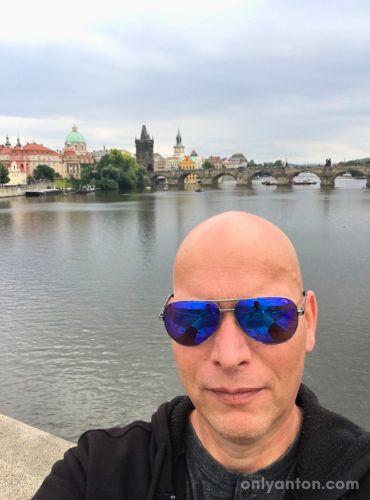
Conclusion
Prague is a city that effortlessly blends its rich history with modern charm, making it a must-visit destination for any traveller. From the stunning architecture and historical significance of the Old Town, including the iconic Charles Bridge and Astronomical Clock, to the picturesque streets and cultural depth of Malá Strana and the vibrant energy of Nové Město, every corner of Prague offers something unique.
Exploring key sights like Prague Castle, St. Vitus Cathedral, Strahov Monastery, and the bustling Wenceslas Square will immerse you in centuries of history and culture. Don’t miss out on the culinary delights of Czech cuisine, whether enjoying a traditional dish or sampling some of the world’s best beers in Prague’s famous beer gardens.
Prague’s seamless blend of history, culture, and modernity ensures something for everyone. Whether wandering through the charming old streets, visiting historic landmarks, or enjoying a pint in a local beer garden, the city promises an unforgettable experience.
Stay tuned for more detailed posts on the Only Anton travel blog. I will dive deeper into the Art Nouveau movement and Alphonse Mucha’s contributions and explore the rich and diverse world of Czech cuisine. Prague awaits your discovery, offering a journey through time and a feast for the senses.
What About You?
I’d love to hear from you! Have you visited Prague or other historic cities? Share your experiences, favourite historical sites, and personal travel tips in the comments below. Did you have a memorable meal, discover a hidden gem, or learn something fascinating about the city’s history? Your stories and insights can inspire fellow readers to explore new destinations.
Here are a few questions to get the conversation started:
- What was your favourite historical site in Prague, and why?
- Do you have any tips for first-time visitors to Prague?
- Have you visited other historic cities that left a lasting impression?
Join the conversation and help build our community of travel enthusiasts. Don’t forget to subscribe to the Only Anton travel blog for more travel stories, tips, and insights. By subscribing, you’ll stay updated on our latest posts, including upcoming detailed guides on Art Nouveau in Prague and the best of Czech cuisine. Happy travels!
Further Reading and Resources
For those interested in diving deeper into the rich history and vibrant culture of Prague, here are some suggested resources and related content on the Only Anton travel blog:
Related Blog Posts on Only Anton
- Aachen Travel Guide: Explore the historical significance of Aachen and its connection to Charlemagne, offering insights into one of Europe’s most fascinating historical figures.
- The Art of Alphonse Mucha: (Coming soon) Discover the life and works of Alphonse Mucha, a leading figure in the Art Nouveau movement, and learn about his influence on Prague’s artistic landscape.
The following resources will give you a well-rounded understanding of Prague’s history, culture, and travel opportunities, enhancing your knowledge and appreciation of this captivating city. Happy reading and happy travels!
Recommended Books
- “Prague: A Cultural and Literary History,” by Richard D. E. Burton (2003): A comprehensive guide to Prague’s cultural and literary past, providing a deep dive into the city’s rich heritage. Find it online, at a library, or get your copy here.
- “The Book of Prague: A City in Short Fiction,” edited by Ivana Myšková and Jan Zikmund (2023): A collection of short stories set in Prague, offering diverse perspectives on the city’s unique character. Look for it online, at a local library, or get your copy here.
- “The Good Soldier Švejk,” by Jaroslav Hašek (1921): A classic Czech novel that provides a satirical look at World War I through the eyes of its endearing protagonist, set against the backdrop of Prague and beyond. Read it online, at a library, or buy your copy here.
Articles on Prague’s History
- “History in Prague,” Frommer’s: An overview of Prague’s history provided by the reputable Frommer’s guide. Read the article here.
- “Thirty Years’ War,” History.com (2018): An article from History.com detailing the Thirty Years’ War, including the famous defenestrations and their impact on European history. Find the article here.
Travel Guides
- “Lonely Planet Prague & the Czech Republic” by Lonely Planet: A comprehensive travel guide offering detailed information on Prague’s attractions, accommodations, and cultural experiences. Find the site here.
- “Rick Steves Prague & The Czech Republic” by Rick Steves: A practical guide for travellers, providing insights into the best sights, food, and accommodations in Prague. Visit the site here.
Reputable Websites for More Information
- Prague.eu: The official tourism website for Prague offers extensive information on attractions, events, and practical tips for visitors. Follow this link.
- Czech Tourism: The official Czech Republic tourism site provides valuable resources for planning your trip to Prague and beyond. Visit the site here.
- Tripadvisor: Prague Travel Guide: User-generated reviews, tips, and travel advice for visiting Prague, including recommendations for attractions, restaurants, and hotels. Find the information here.





Nice to see photos included in the article.